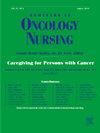通过社区宣传和其他有针对性的方法招募西班牙裔、非西班牙裔黑人和其他非白人癌症幸存者的经验。
IF 2.3
4区 医学
Q1 NURSING
引用次数: 0
摘要
目标:在肿瘤学研究中招募未得到充分服务的种族/族裔人群对于解决健康差异问题至关重要。本文介绍了在一项调查健康行为的生物心理社会决定因素的试点研究中招募非西班牙裔黑人、西班牙裔和其他非白人癌症幸存者的社区外展和其他方法的策略和经验教训:我们对参与者招募方法进行了严格审查,以探索挑战和成功策略,并为未来研究提出建议。直接招募策略包括与研究人员的个人社区联系人/联络人接触,以及参加社区外展活动(如农贸市场、街区聚会、图书馆活动、癌症宣传活动)。间接招募策略包括在社区中心(如基督教青年会、教堂、图书馆的 LIVESTRONG®)、在线平台(如 FORCE、Survivor Journey 网站)张贴和分发研究传单,以及向通过单一州癌症登记处确定为符合条件的个人发送邀请信:2022 年 4 月至 2023 年 5 月间,在招募的 64 人中,36 人为非西班牙裔黑人,25 人为西班牙裔,3 人为美国印第安人/阿拉斯加原住民。在这项研究中,最有效的策略是使用州癌症登记处(64.1%)、滚雪球/口口相传(7.8%)以及通过已有的癌症支持组织(即 FORCE)网站发布广告(7.8%):结论:通过社区参与式研究招募非西班牙裔黑人、西班牙裔和其他非白人参与生物行为研究具有挑战性,需要目标社区和附属组织的长期承诺和合作伙伴的参与:对护理实践的启示:登记处和社区外联活动可以为成功注册建立信任。采用多种策略可为接触不同人群并让他们参与癌症相关研究提供最佳机会。本文章由计算机程序翻译,如有差异,请以英文原文为准。
Experiences in Recruitment for Hispanic, Non-Hispanic Black, and Other Non-White Cancer Survivors Through Community Outreach and Other Targeted Approaches
Objectives
Recruitment of racial/ethnic underserved populations in oncology research is essential to address health disparities. This article presents strategies and lessons learned from community outreach and other approaches for recruiting non-Hispanic Black, Hispanic, and other non-White survivors of cancer into a pilot study that investigated biopsychosocial determinants of health behaviors.
Methods
We critically examined the participant recruitment approaches to explore challenges and successful strategies and develop recommendations for future studies. Direct recruitment strategies included engaging with research staff members’ personal community contacts/liaisons and participating in community outreach events (eg, farmers’ markets, block parties, library events, cancer awareness events). Indirect recruitment strategies included posting and distribution of study flyers in community centers (eg, LIVESTRONG® at the YMCA, churches, libraries), online platforms (eg, FORCE, Survivor Journey website), and invitation letters sent to individuals identified as eligible through a single state cancer registry.
Results
Between April 2022 and May 2023, among the 64 individuals recruited, 36 were non-Hispanic Black, 25 were Hispanic, and three were American Indian/Alaska Native people. The use of a state cancer registry (64.1%), snowballing/word of mouth (7.8%), and advertisement through an established cancer support organization (ie, FORCE) website (7.8%) were the most effective strategies in this study.
Conclusion
Recruitment of non-Hispanic Black, Hispanic, and other non-White people into biobehavioral studies through community-engaged research is challenging and requires long-term commitment and engagement with partners from target communities and affiliated organizations.
Implication for Nursing Practice
Registries and community outreach events can build trust for successful enrollment. Using multiple strategies can provide the best opportunities to reach diverse populations and enroll them in cancer-related research studies.
求助全文
通过发布文献求助,成功后即可免费获取论文全文。
去求助
来源期刊

Seminars in Oncology Nursing
Nursing-Oncology (nursing)
CiteScore
3.40
自引率
0.00%
发文量
68
审稿时长
45 days
期刊介绍:
Seminars in Oncology Nursing is a unique international journal published six times a year. Each issue offers a multi-faceted overview of a single cancer topic from a selection of expert review articles and disseminates oncology nursing research relevant to patient care, nursing education, management, and policy development.
 求助内容:
求助内容: 应助结果提醒方式:
应助结果提醒方式:


